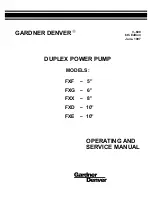
6
Double Pump Series - Single Stage – Large and Intermediate Series Combination
VVSF-14-40
VVSF-18-40
VVSF-22-40
VVSF-28-40
VVSF-36-40
VVSF-14-48
V-350-FT
VVSF-22-48
V-353-FT
V-356-FT
VVSF-14-60
V-450-FT
VVSF-22-60
V-453-FT
V-456-FT
Model Numbers
Delivery, gpm
Horsepower Input
Foot
Mounting
Flange
Mounting
500
psi
1000
psi
0
psi
14.4
18.3
21.9
28.8
35.9
14.4
18.3
21.9
28.8
35.9
14.4
18.3
21.9
28.8
35.9
500
psi
1000
psi
0
psi
13.3
17.1
20.8
27.6
33.9
13.3
17.1
20.8
27.6
33.9
13.3
17.1
20.8
27.6
33.9
.70
.75
.85
1.00
1.20
.70
.75
.85
1.00
1.20
.70
.75
.85
1.00
1.20
5.8
6.7
8.1
9.7
13.5
5.8
6.7
8.1
9.7
13.5
5.8
6.7
8.1
9.7
13.5
10.9
12.4
14.9
18.8
24.1
10.9
12.4
14.9
18.8
24.1
10.9
12.4
14.9
18.8
24.1
Delivery, gpm
Horsepower Input
500
psi
1000
psi
0
psi
41.7
39.5
500
psi
1000
psi
0
psi
37.2
1.6
14.0
26.5
15.4
19.4
22.9
29.9
37.8
15.4
19.4
22.9
29.9
37.8
15.4
19.4
22.9
29.9
37.8
48.5
46.8
45.0
2.0
16.5
31.5
60.6
58.3
56.0
2.7
2.0
38.4
VVSG-14-40
VVSG-18-40
VVSG-22-40
VVSG-28-40
VVSG-36-40
VVSG-14-48
V-350-FL
VVSG-22-48
V-353-FL
V-356-FL
VVSG-14-60
V-450-FL
VVSG-22-60
V-453-FL
V-456-FL
Small Volume - Head End Pump
Large Volume - Shaft End Pump
Section II – Description
This manual contains service and maintenance information
for Vickers single and double pumps. These hydraulically
balanced cartridge type vane pumps are used to provide a
constant supply of hydraulic fluid under pressure and are
produced in three basic housing sizes: small, intermediate
and large. Cartridges of different displacement may be used
interchangeably in each series. These pumps can be used
as single units or two may be assembled on a common drive
shaft (double pump) providing an almost infinite number of
combinations. Figure 1 illustrates a cross sectional view of a
flange mounting, small and intermediate series combination
double pump, assembled for left hand rotation.
Figure 1.
Section III – Principles of Operation
A. Operation
Pumping is performed by cartridges consisting of a ring,
rotor, two bushings, twelve vanes and a locating pin or
screws (see Figure 2). The splined pump shaft rotates
driving a slotted rotor. Vanes within the rotor slots are thrown
out by centrifugal force and held out by system pressure to
follow a double lobed cam ring. Movement of the vanes in
and out as they follow the cam causes the chambers
between them to increase in size and pick up fluid from the
reservoir as the vanes cross the inlet porting. Chamber size
decreases when the vanes cross the outlet porting forcing
fluid out into the system.
The size of the cartridge ring determines the pump
displacement. Ring change alters delivery. However, the 11
gpm ring in the small series and the 36 gpm ring in the
intermediate series are used with wide vanes and rotor so
conversions to these capacities require additional change of
rotor, vanes and head.
B. Lubrication
None is required for current design models. Older designs
require lubrication of the front shaft bearing. A grease fitting
is provided on top of the pump body. (Some of the larger
pumps also incorporate a grease relief fitting on the bottom
of the body.) It is recommended that these fittings be
lubricated sparingly (approximately one tablespoonful every
six months) with a low pressure gun using a good quality,
high temperature, bearing grease.






























